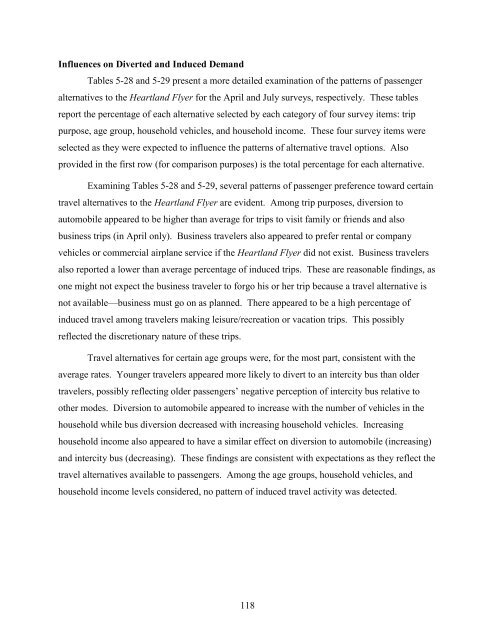Measuring the Benefits of Intercity Passenger Rail: A Study
Measuring the Benefits of Intercity Passenger Rail: A Study
Measuring the Benefits of Intercity Passenger Rail: A Study
Create successful ePaper yourself
Turn your PDF publications into a flip-book with our unique Google optimized e-Paper software.
Influences on Diverted and Induced Demand<br />
Tables 5-28 and 5-29 present a more detailed examination <strong>of</strong> <strong>the</strong> patterns <strong>of</strong> passenger<br />
alternatives to <strong>the</strong> Heartland Flyer for <strong>the</strong> April and July surveys, respectively. These tables<br />
report <strong>the</strong> percentage <strong>of</strong> each alternative selected by each category <strong>of</strong> four survey items: trip<br />
purpose, age group, household vehicles, and household income. These four survey items were<br />
selected as <strong>the</strong>y were expected to influence <strong>the</strong> patterns <strong>of</strong> alternative travel options. Also<br />
provided in <strong>the</strong> first row (for comparison purposes) is <strong>the</strong> total percentage for each alternative.<br />
Examining Tables 5-28 and 5-29, several patterns <strong>of</strong> passenger preference toward certain<br />
travel alternatives to <strong>the</strong> Heartland Flyer are evident. Among trip purposes, diversion to<br />
automobile appeared to be higher than average for trips to visit family or friends and also<br />
business trips (in April only). Business travelers also appeared to prefer rental or company<br />
vehicles or commercial airplane service if <strong>the</strong> Heartland Flyer did not exist. Business travelers<br />
also reported a lower than average percentage <strong>of</strong> induced trips. These are reasonable findings, as<br />
one might not expect <strong>the</strong> business traveler to forgo his or her trip because a travel alternative is<br />
not available—business must go on as planned. There appeared to be a high percentage <strong>of</strong><br />
induced travel among travelers making leisure/recreation or vacation trips. This possibly<br />
reflected <strong>the</strong> discretionary nature <strong>of</strong> <strong>the</strong>se trips.<br />
Travel alternatives for certain age groups were, for <strong>the</strong> most part, consistent with <strong>the</strong><br />
average rates. Younger travelers appeared more likely to divert to an intercity bus than older<br />
travelers, possibly reflecting older passengers’ negative perception <strong>of</strong> intercity bus relative to<br />
o<strong>the</strong>r modes. Diversion to automobile appeared to increase with <strong>the</strong> number <strong>of</strong> vehicles in <strong>the</strong><br />
household while bus diversion decreased with increasing household vehicles. Increasing<br />
household income also appeared to have a similar effect on diversion to automobile (increasing)<br />
and intercity bus (decreasing). These findings are consistent with expectations as <strong>the</strong>y reflect <strong>the</strong><br />
travel alternatives available to passengers. Among <strong>the</strong> age groups, household vehicles, and<br />
household income levels considered, no pattern <strong>of</strong> induced travel activity was detected.<br />
118
















